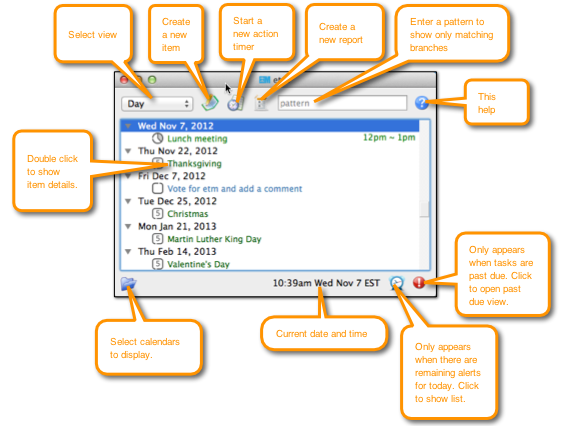
etm is an acronym for event and task manager. It provides a format for using plain text files to store actions, events, notes, and tasks. Items can be created, modified and viewed in a variety of convenient ways using either using the command line or a cross-platform, PyQt based GUI. Available data types are discussed in the Data section. Possible views include Day, Week, Month, Now, Next, Folder, Keyword and Tag. These are discussed in the Views section. Custom, report views that can be exported and printed are discussed in the Reports section. There are keyboard shortcuts for all actions which are discussed in the Shortcuts section. Possible user preference settings are discussed in the Preferences section.
The main window is illustrated below with the Day view selected.

Use Control-J to jump to a fuzzy parsed date, e.g., "-1/1" to go the first day of the previous month or "+90" to go to the date that is 90 days from today. The Day, Week and Month views will all change to show the selected date.
etm's main goal is to make Getting Things Done easier. Commonly abbreviated as GTD, Getting Things Done is an action management method, and the title of a popular book by David Allen. It rests on the common sense notion that with a complete and current inventory of all commitments, organized and reviewed in a systematic way, the mind is freed from the job of remembering everything that needs to be done, and can focus on actually performing those tasks.
Three observations are critical:
Projects usually involve a series of steps, some of which must be carried out consecutively, e.g., parts must be acquired before assembly can begin.
The steps of a project are carried out in a context which may vary from step to step, e.g., parts may be acquired in the context 'errands' but assembly may be in the context 'workshop'.
While focusing on projects is great for planning, for actually doing things it would be more convenient to focus on context so that, for example, you could see all actions from all projects with context 'errands' before you drive off. To focus on what needs to be done, it would also be useful to be able to deemphasize actions that are not yet available so that, for example, 'assemble parts' is not prominently displayed until 'acquire parts' is complete.
GTD thus requires convenient methods for:
storing and organizing all the bits.
displaying just the information you need, when you need it.
checking the status of all items your projects.
etm allows you to store and organize your commitments using a simple, intuitive format using plain text files. Here, for example, is a simple task
- pay bills @s Oct 25and here is a task group in which the individual jobs must be finished in @q (queue) order, i.e., assemble is a prerequisite for paint.
+ dog house
@j pickup lumber and paint &q 1
@j cut pieces &q 2
@j assemble &q 3
@j paint &q 4Day view shows your commitments grouped and sorted by date. Now view shows your past due tasks grouped into available, waiting and delegated categories and sorted by due date. Next view shows your undated tasks grouped by context and sorted by priority and estimated completion time. Folder view provides project review in a glance by showing your commitments grouped by project file (folder) and displaying the relevant datetimes, i.e., the past due date for past due tasks, the starting datetime for non-repeating items and the datetime of the next instance for any repeating items. Keyword view provides another heirarchial view of your commitments again displaying relevant datetimes but grouped by keyword rather than folder. Tag view shows your commitments grouped by tag. Within each of these views, a filter can be used to limit the display to items matching a case-insensitive, regular expression.
In addition to these built-in views, report view gives you complete freedom to group, sort and filter your data in any way you wish.
In short, etm makes it easy for you to store and organize all the bits and to display just the information you need, when you need it.
etm can be started using the command etm_qt [arguments] in a terminal window. With no arguments, etm will use settings from the configuration file ~/.etm/etm.cfg and open the GUI.
If the first argument is the path to a directory which contains a file named etm.cfg, then settings from that file will be used instead.
If the first argument, other than the optional path, is either "a", "c", "m", "n", "s", "v", "?" or "l" (lower case L), then the remaining arguments will be executed by etm without opening the GUI.
report_specifications in etm.cfg. Use ? m to display the numbered list of entries from this file.? a would display help information about the command a. Enter ? help for details about all of the other commands listed here.See the report help section for details about creating reports and the preferences help section for details about the possible settings for etm.cfg.
Details about item types and options are available in the Data section.
To create a new item, either click on the new item button or press Control-N. This will open an edit window for your entry. When done, click on the Save Icon or press Control-S to save your entry and choose a file from the dialog.
Need to schedule an event? Use the week view to find a free period and then double click on the desired date and time. The editor will open with the date and time you selected already entered.
To create a new action, either click on the new action button or press Control-T to create a new action timer.
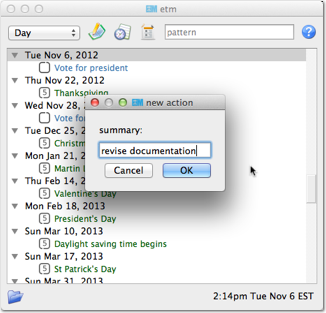
Enter a summary of your new action and press Return to start the timer. The display will change to show timer control buttons and elapsed time:
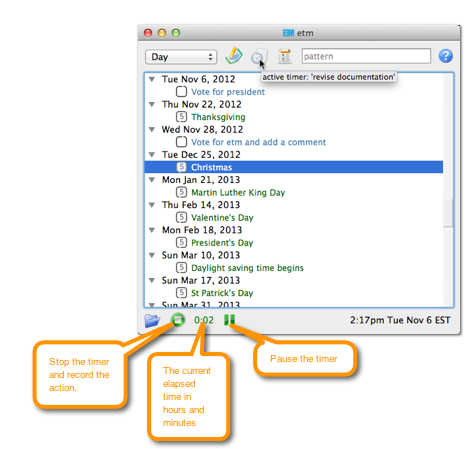
When you are finished, either click on the stop timer button or press Shift + Control-T to stop the timer and open an edit window to record the action. Your summary, the date and time you began the action and the elapsed time will automatically be entered:
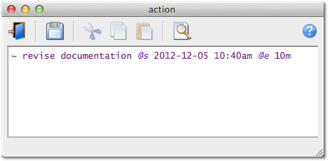
Want to work on a task and record the time you spend? Select the task and then click on "create a new action timer based on this item" to start a timer with all the relevant details of the task already entered.
Need to quickly enter some information before you forget? Press Control-S to open the scratch pad. Type whatever you want to remember. You can either leave the scratch pad open or press Control-Return to close it. When you next open the scratch pad, even if you have closed and restarted etm, your previous entry will be there for you to copy or edit. Additionally, when you are editing a item or an action, you can press Control-I to insert the contents of the scratch pad at the cursor.
To examine the details of an item, either select it and press Return or double click on it. The details of the selected item will be displayed along with a number of possible actions related to the item:
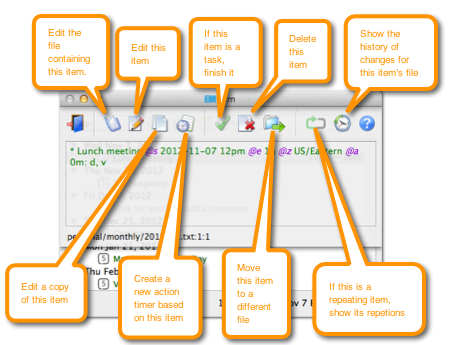
With repeating items, choosing either edit or delete entails a further choice of what to change/delete:
You can enter an expression, either a plain string or a regular expression, in the pattern filter to limit the display in any of the tree (outline) views to items whose summaries (titles) or branches match the pattern. As each character is entered the display is updated to show only items that still match. Note the effect of changing the pattern from "v" to "vo" in the day view below:
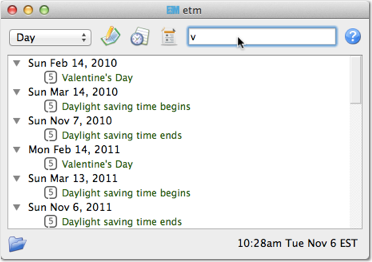
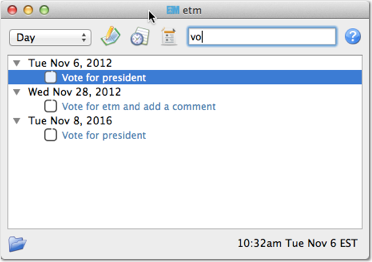
You can identify items with a particular tag by switching to the tag view and then entering a pattern for the tag(s) you want in the pattern filter. Only items from the matching tag branches will be displayed. This approach also works for filtering items in the keyword or folder view, the latter illustrated below. Note that the effect of entering "us" in the pattern filter is to expand the matching branches and summaries:
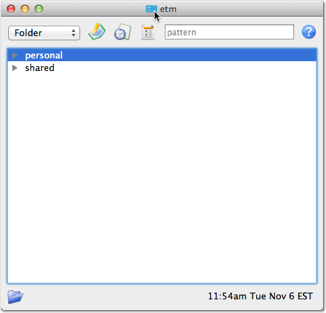
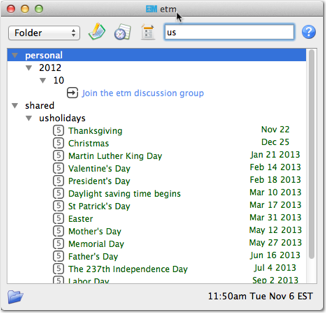
Press Escape to clear the filter and activate the Select view menu.
The etm editor supports both syntax highlighting for etm data files and automatic completion. As illustrated below, different colors are provided for different item types and both @key and &key entries are highlighted. Entries using unsupported keys, such as @h below, are also highlighted as errors.
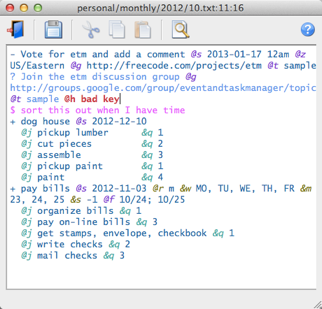
Automatic completion uses a list of possible completions in a text file specified by auto_completions in your etm.cfg. Each line in this file provides a possible completion, for example:
@c computer
@c home
@c errands
@c office
@c phone
@z US/Eastern
@z US/Central
@z US/Mountain
@z US/Pacific
dnlgrhm@gmail.comAs soon as you enter "@c", for example, a list of possible context completions will pop up and then, as you type further characters, the list will shrink to show only those that still match:

Up and down arrow keys change the selection and either Tab or Return inserts the selection.
Pressing Ctrl-S in the etm main window will open a schedule dialog showing items from your day view for the next few days plus items, if any, from your now and next views. This schedule can be printed or sent by email to an address you specify. Using settings for agenda in your etm.cfg the display can be customized to, for example, fit nicely in the display of your mobile phone:
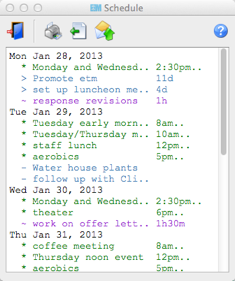
If you set current_htmlfile and/or current_textfile in your etm.cfg then etm will automatically update the contents of the relevant files with with your current schedule. You could then, for example, use the text file with geektool to display your current schedule on your desktop. Another option would be to place current_textfile in your Google Drive or Dropbox and thus have automatic access to your current schedule in your mobile device. Here's mine on my iPhone:
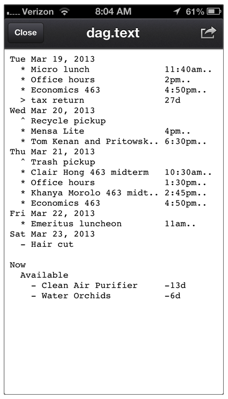
Both the schedule and report dialogs support exporting displayed items in CSV (comma separated values) format to a file you specify. Files in this format can be imported by most spreadsheet programs.
Pressing F8 in the main windown will export items in iCalendar format to the file specified by icscal_file in etm.cfg. If calendars is set in your etm.cfg, then only items from selected calendars will be exported, otherwise all items will be exported. This file can be imported by most calendar applications.
Pressing F8 in the details view will export the selected item in iCalendar format to the file specified by icsitem_file in etm.cfg. This file can, for example, be attached to an email to share the details of the item. If the item is repeating, you will have the choice of exporting 1) just the selected instance, 2) the selected and all subsequent instances or 3) all instances.
Pressing Shift-F8 in the main window will open dialogs first to select an .ics file to import into etm and then to select an etm data file to hold the imported item(s). This file will then be opened for editing with the added item(s) selected.
iCalendar export and import limitations
Although tasks are exported as VTODO elements and notes and actions as VJOURNAL elements, these elements will be ignored by most calendar applications.
Additionally, Apple's iCal does not support some repetition features. Dates added using etm's @+, for example are not recognized by iCal though they are by Google Calendar and most other calendar apps.
Currently, etm @a alerts are not exported. Task groups are exported as standard tasks.
etm's version numbering now uses the major.minor.patch format where each of the three components is an integer:
Major version numbers change whenever there is a large or potentially backward-incompatible change.
Minor version numbers change when a new, minor feature or a set of smaller features is introduced or when a status change has occured. A change in the minor version from zero to one, for example, indicates a change in the status of the major version from alpha to beta. Minor version numbers greater than one indicate production/stable status.
Patch numbers change for new builds involving small bugfixes or the like. Some new builds may not be released.
When the major version number is incremented, both the minor version number and patch number will be reset to zero. Similarly, when the minor version number is incremented, the patch number will be reset to zero. All increments are by one.